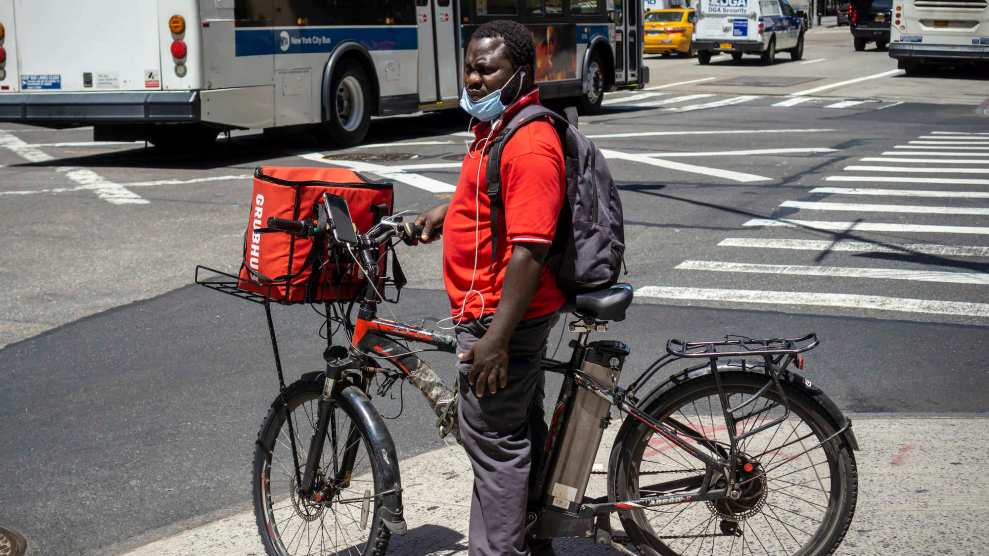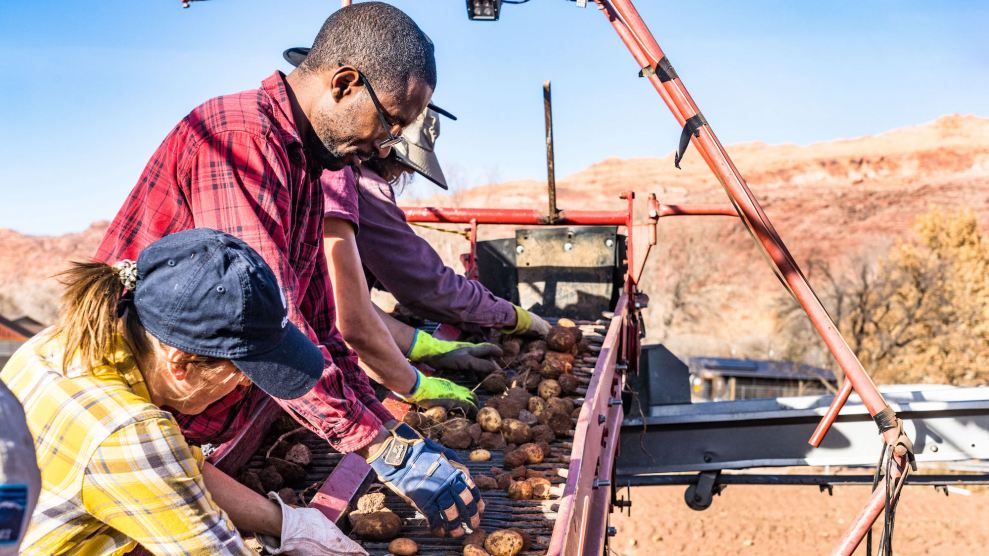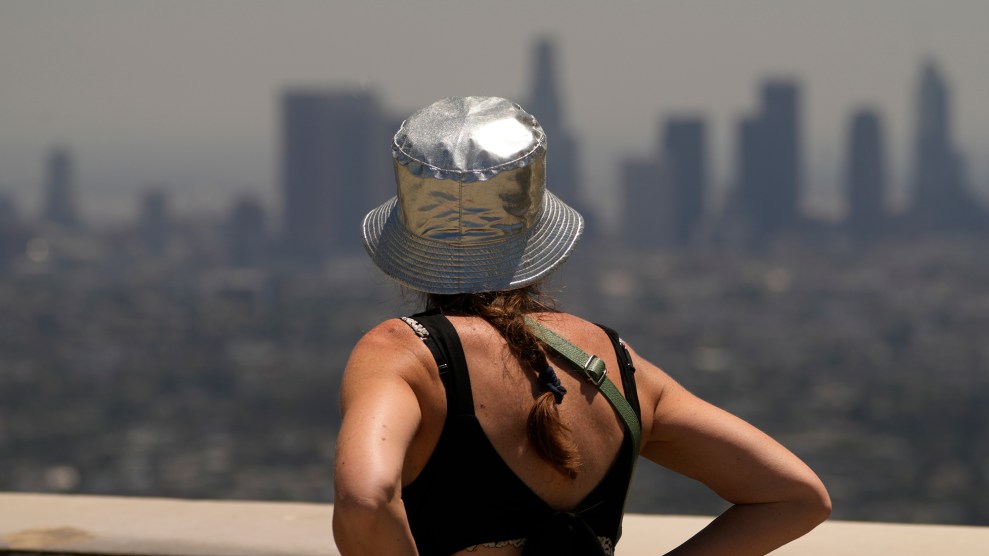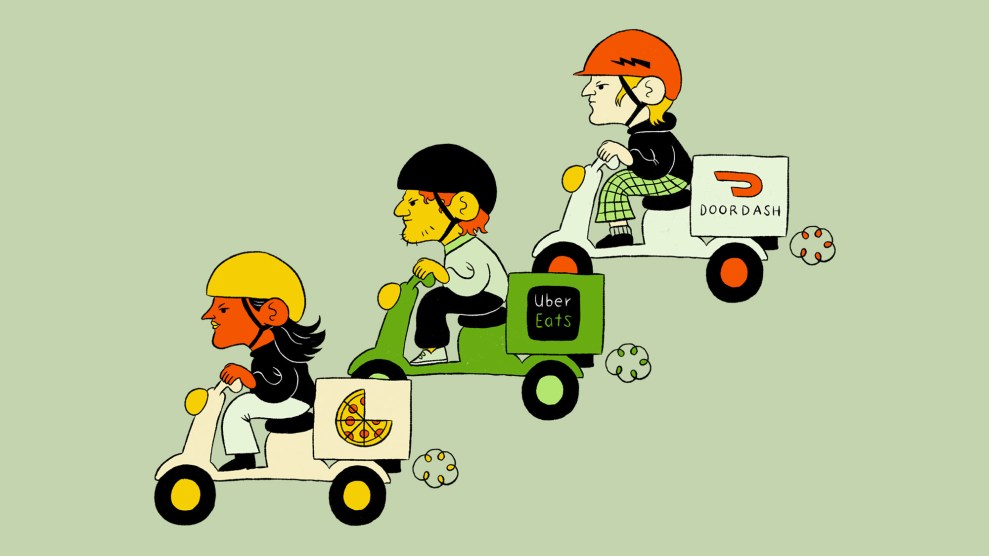
Richard B. Levine/Levine Roberts/ZUMA
This story was originally published by Inside Climate News and is reproduced here as part of the Climate Desk collaboration.
Jessica Fawcett wakes up at 5:30 a.m. so she can deliver groceries and take-out orders throughout Tempe, Arizona. She has been working 12- to 14-hour shifts for Instacart and DoorDash since December, but lately, the heat in Tempe has been making them harder.
Some days, Fawcett must walk 20 minutes or climb four floors of stairs in a 116-heat index just to deliver one order. “I joke and say I don’t need to go to the gym because I already walk a lot with this heat,” she says. “I have lost so much weight.”
The National Oceanic and Atmospheric Administration reported this year’s June was the hottest the Earth has ever registered, and last week the Copernicus Climate Change Service said July was the hottest month ever recorded. High temperatures have continued this month, and over 100 million Americans were under an extreme heat alert at some point during July.
Nevertheless, app delivery workers in states with extreme weather, like Arizona and Texas, have kept working. Some feel the consequences on their health, and others are changing their working hours and carrying around cold water to survive long shifts in the blistering heat.
“It feels like you are standing in an air fryer or a microwave,” says Hector Mejía, a 30-year-old who has been working doing DoorDash deliveries in Phoenix for around a year. He compares heat these days in Arizona with standing next to a campfire. “It’s almost hard to breathe.”
The number of people working for app delivery platforms in the US has exponentially increased in the last few years, from just over one million in 2018 to over four million in 2021, a recently published study found. That represents almost three times Amazon’s global workforce.
While some platform workers like the flexibility of the job, they are especially vulnerable to inclement weather, sickness, or any situation that keeps them from working since, as independent contractors, their livelihood depends on them being on the streets.
In New York City, app delivery workers have been fighting to get an hourly minimum wage, but in the rest of the country, organization efforts are scarce, said Ligia Guallpa, the executive director of the Workers Justice Project, an organization that has supported app delivery workers in New York.
“Unlike workers in traditional job markets, app delivery workers have no labor rights,” says Guallpa. “In extreme heat, a construction worker has the right to ask their employer to provide them with secure job conditions and their employer has the obligation to provide that to them, but that is not the case with platform workers.”
To cope with extreme weather, some app delivery workers have changed routines to avoid the hottest hours of the day. Mejía, for example, usually works 10 to 12 hours a day starting in the early morning but recently has begun taking a break in the afternoon to take a nap in his home’s air conditioning. To keep making the money he usually makes, he has been working until past midnight.
Other “Dashers,” as the app calls them, like Fawcett, have kept doing the 12-hour shifts they usually work. “If I want to make any type of decent money, these are the best hours for me,” said Ashlynn, a delivery worker in Jack County, Texas, referring to lunch and dinner hours. “Changing the time, because of the heat, I probably wouldn’t make the money that I need to do.” Ashlynn asked that her last name be withheld to protect her privacy.
Hot weather also means drivers get less money from their work. Summer is a slower season than winter for food delivery, they say, and may mean waiting for new orders with the car air conditioning running, which increases gas bills. “That is gas that the apps don’t pay you for,” said Luis Berti, a delivery worker in Houston who also has a YouTube channel for Hispanic delivery workers.
“I always have air conditioning, but some of my colleagues turn down their cars and wait with their doors open even if they are dying of heat,” said Sofía Camarena, who lives in Euless, Texas, a small town that has been under an extreme heat advisory almost all of August. Drivers have also seen their vehicles suffer because of the extreme weather. “People have had their tires burst,” she said.
Last week, Ashlynn’s AC blower stopped working when it overheated, and the temperature was higher inside her car than outside. “It was 105 degrees, but my car said 110,” she said. “When I’m sitting in my vehicle, I have one vent that goes directly toward my face and one that goes directly toward my phone. Because it gets so hot that my phone overheats. And then I can’t work because my job is all about my phone.”
To keep herself hydrated, Camarena carries iced coffee and cold water. In Door Dash’s Reddit forums and Facebook groups, “Dashers” encourage each other to keep hydrated, but that is not enough to combat the heat.
“You can’t just hydrate yourself out of this,” said Cecilia Sorensen, a medical doctor and the director of the Global Consortium on Climate and Health Education at Columbia University. While dehydration can make things worse, it is not the main cause of heat stroke. “Water doesn’t fix this,” Sorenson said. “It is not driven by dehydration, but directly by heat exposure.”
Human bodies cool themselves through breathing and sweating, Sorensen said, but they can cross a threshold where physiologically they cannot compensate for exposure to heat. “We need to be kept in a very narrow, comfortable temperature for our bodies to function,” she said. “Once we exceed that temperature, we start having a breakdown in many physiologic processes that keep us alive.”
One of the solutions Sorensen advocates is to have a federal mandate to prohibit making people work above a certain temperature, and the Biden administration recently announced it would issue a hazard alert for heat that would “reaffirm that workers have heat-related protections under federal law.” Despite the announcement, she said, “they have not done it yet.”
A spokesperson for DoorDash told Inside Climate News in an email that it sends regular reminders to Dashers on ways to stay safe while on the road, including tips on working during extreme heat.
“We are constantly monitoring severe weather conditions across the country and can take necessary precautions to help keep our communities safe—including sending proactive warnings, switching to customer pick-up only, or suspending all operations in impacted areas,” the spokesperson said.
DoorDash said it has shut down operations three times in the past two months, but never because of extreme heat. A shutdown in Denver was due to hail, and the other two in Mayfield, Kentucky, and Montpelier, Vermont, were due to heavy rain and flooding.
Most drivers work for more than one delivery app, but DoorDash comprises 64 percent of all food delivery sales, according to Bloomberg Second Measure. Grubhub, Uber, and Instacart didn’t respond to Inside Climate News’ requests for comment.
In early Covid, some app delivery companies offered those who work full-time financial assistance so they could stay home if they were sick, but that hasn’t been the case with the weather this summer. “I don’t think the apps are aware of what drivers are dealing with and have to go through,” said Britni Duwii, a delivery worker in Mesa, Arizona.
“A few more months,” said Mejía about the hot days he still has ahead. “Usually, by the middle of October, it starts getting cooler.”













